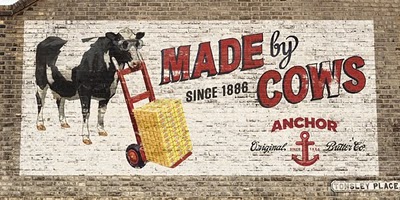Made by cows
This image that I spotted on the excellent Delicious Industries site the other day definitely made me chuckle. It is amusing, well-designed, memorable, and frankly just really cool. Certainly all qualities that can often be lacking in advertising today. I gather the copy writer and artist were trying to emphasize the wholesomeness and adherence to the dairy company’s commitment to quality and freshness. Other images in the series of spots illustrate the cow driving a farm tractor and churning the butter (although I imagine the lack of opposable thumbs would make that feat kind of tricky).
can often be lacking in advertising today. I gather the copy writer and artist were trying to emphasize the wholesomeness and adherence to the dairy company’s commitment to quality and freshness. Other images in the series of spots illustrate the cow driving a farm tractor and churning the butter (although I imagine the lack of opposable thumbs would make that feat kind of tricky).
But after thinking about the images a bit more, I think there is a larger, more general message as well. That is without the cows who provide the essential raw materials for the dairy’s products, then well, there are no products. Sure, farmers look after the cows health and well-being, engineers design systems and machinery to efficiently collect the raw milk and then process it accordingly, and a small army of marketers, salespeople, logistics pros, accountants, HR folks, and all kinds of others move in and around the process making sure the raw milk turns in to end products, the products are packaged, sold, shipped, counted up, paid for, and that the people involved in the process are also paid, trained, and otherwise looked after.
More and more companies, and consequently increasingly numbers of jobs don’t actually involve making anything tangible like butter or cheese. So the intangible end products and services then must have intangible raw materials as well. The ideas, insights, and eureka moments that can improve, alter, redefine, or reinvent the product or process or simply the way that the all the support people in the organization go about their work, these are the new raw materials, the raw milk if you will of the new enterprise. In the butter making business, acquiring the raw milk really isn’t the hard part, sure capital and some expertise is required, but for the most part the getting the right cows pretty much guarantees a steady supply of raw materials. After a while the business success and survival depends almost totally on what happens after the raw materials arrive. The super stars of the organization often were the ones farthest remove from where the raw milk was produced and came in the door.
Now success, and the people that might be the most valuable contributors to that success are the ones that provide the raw materials. The ideas. The breakthroughs. It used to be a pretty lousy position to be in, to be strapped to a milking machine a few times a day. Now, if you are someone that can consistently produce the raw materials of the enterprise, you are in a really prime position.
So which one are you? A cow, or someone who looks after the cows?

 Steve
Steve





